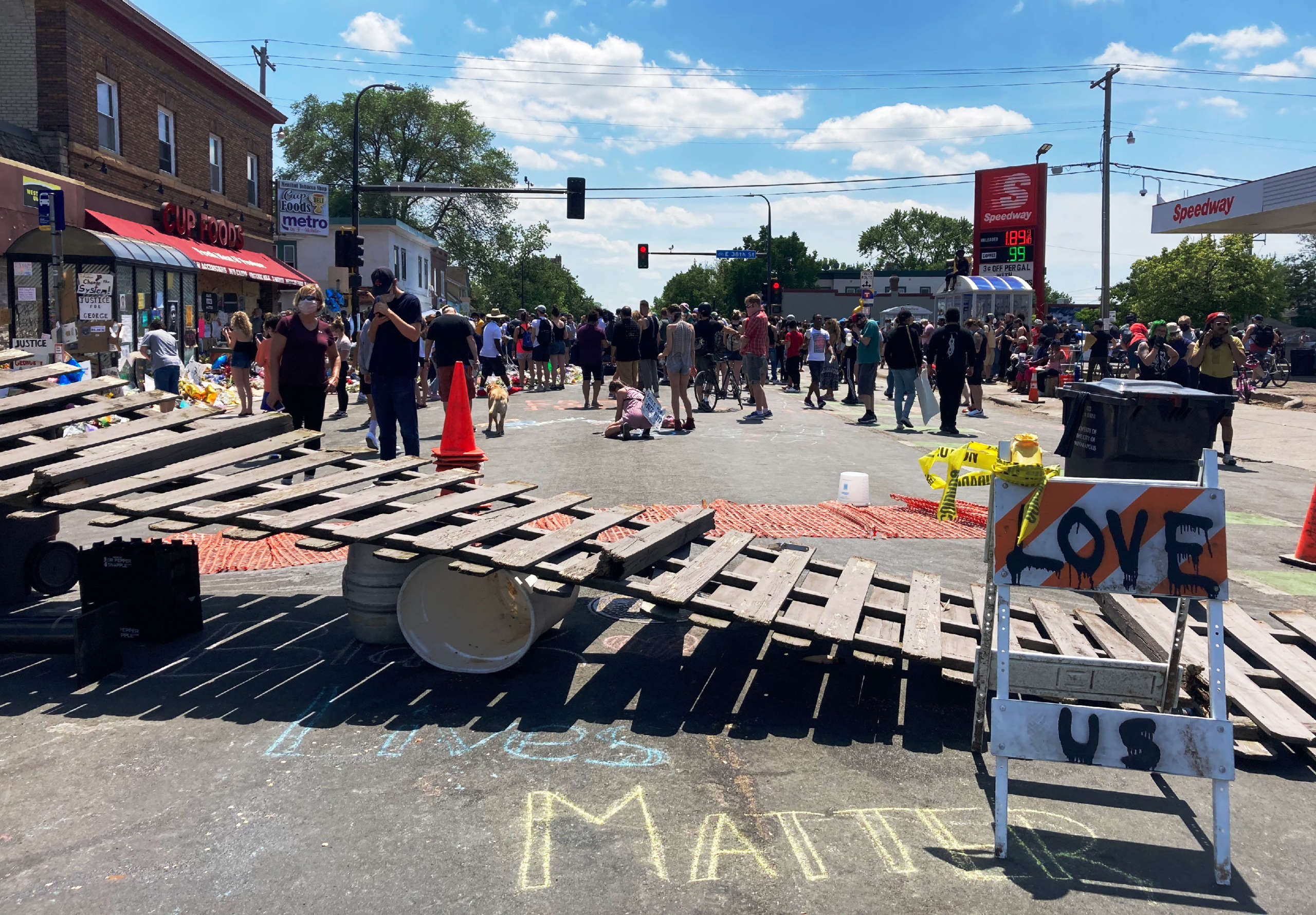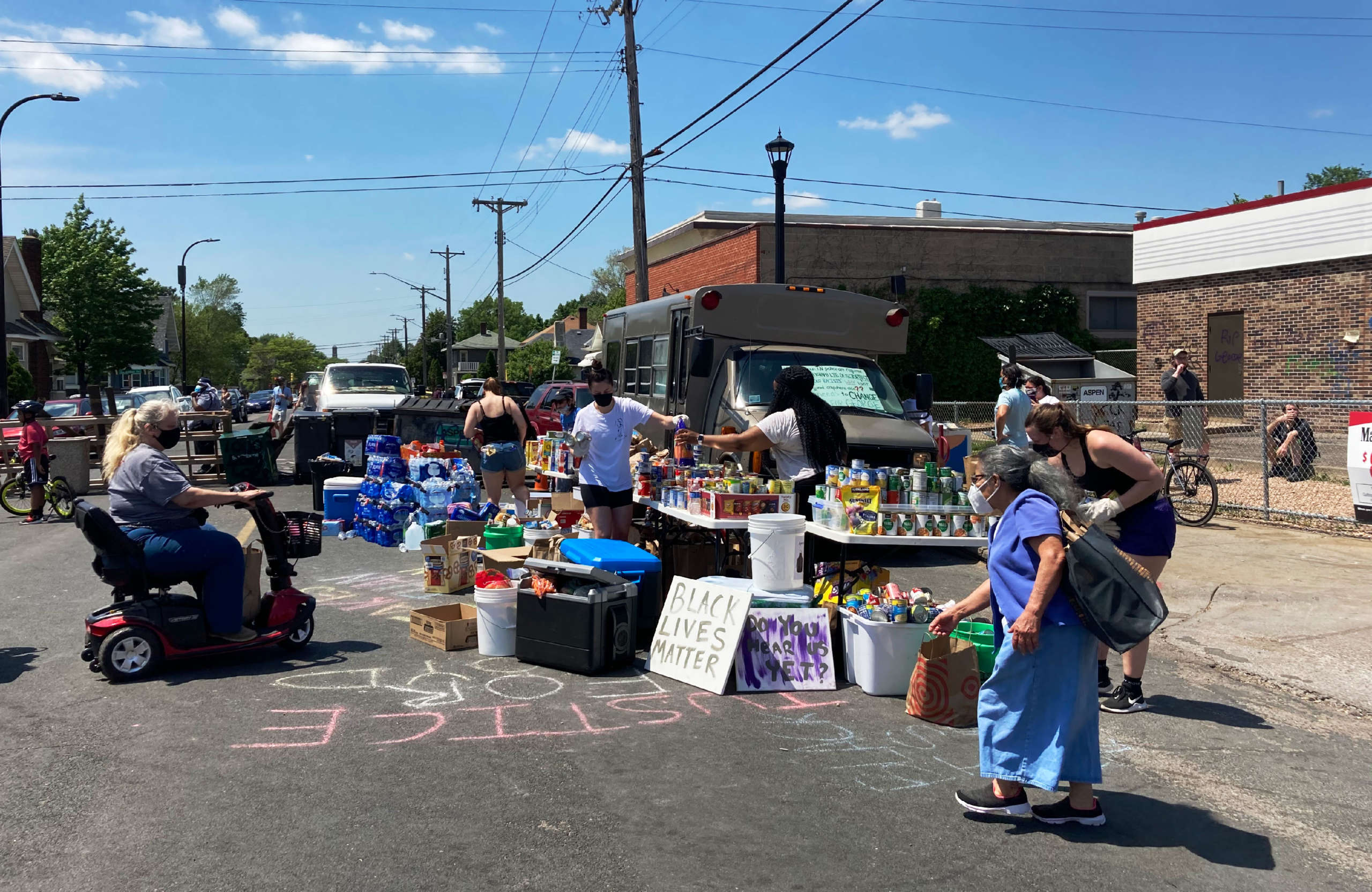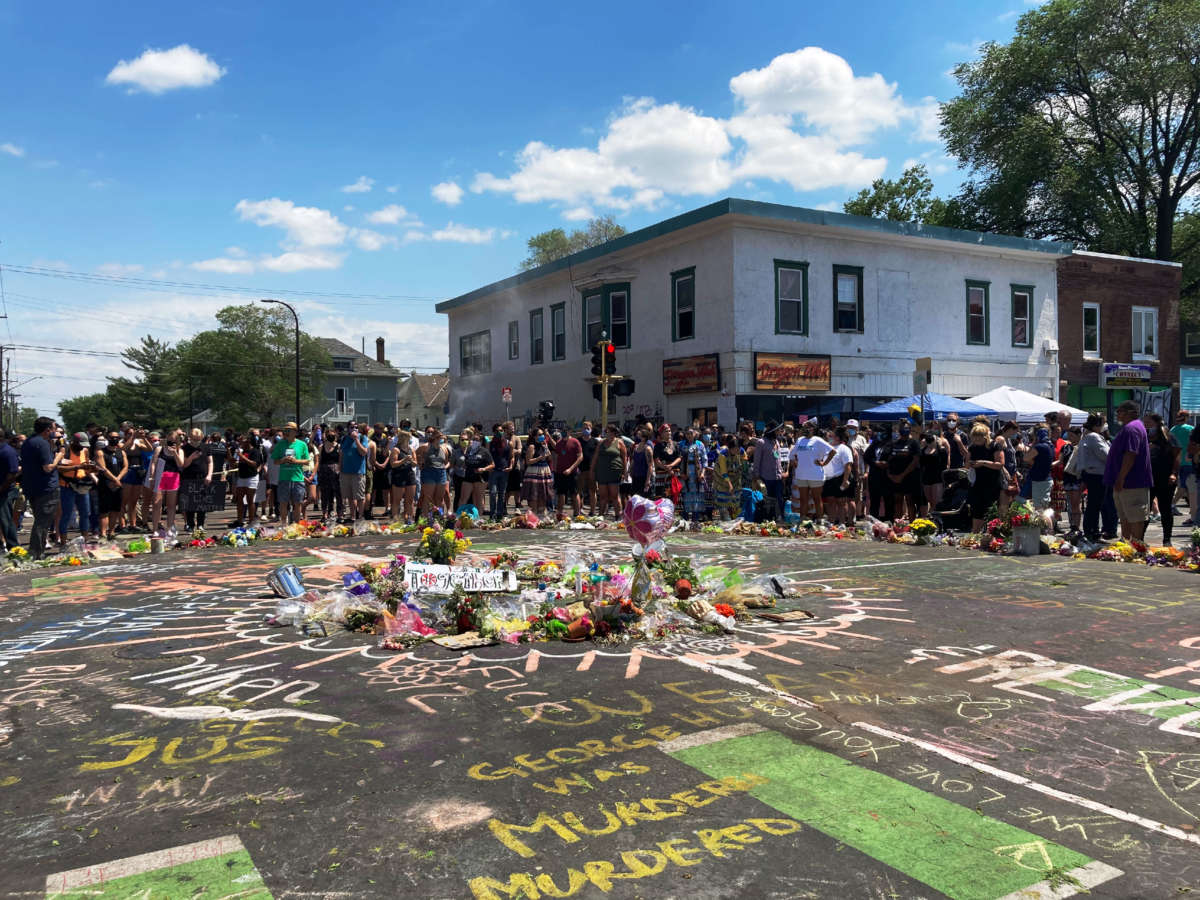As protests against racism and state violence continue nationwide following the killing of George Floyd, neighborhoods in Minneapolis are facing increasingly brutal police crackdowns and heavy militarization of the city by the National Guard. And even as Minneapolis residents continue agitating against police violence, some are also organizing to defend themselves against the threat of violence from white supremacists who have been accused of coming to the city to burn buildings in neighborhoods of color and cause chaos.
“So many incredible organizations in Minneapolis are doing powerful work to keep people safe in the streets; defend Black, Indigenous, and other targeted communities from the police and white supremacists; rebuild our city; feed people; offer healing support and building long-term infrastructure to keep us safe from police,” said members of the Black Visions Collective, an police abolitionist group in Minneapolis, in a letter to supporters.
When I arrived in the Powderhorn neighborhood in South Minneapolis on Sunday night, two men were holding handguns and standing near a street corner. It was two hours past the 8 p.m. curfew that police were enforcing by violently breaking up protests that local media reported to be peaceful. I had just returned from Lake Avenue, where businesses are boarded up after several nights of looting and fires. The men introduced themselves as Michael and William, two neighbors who recently met and were now working together to run security for their block.
“We are here protecting our block now,” said William, a Latino man who believes that some of the “people who are doing damage in Minnesota are … white supremacists.”
William’s concerns are warranted: Law enforcement officials claimed Sunday that white supremacist “agitators” had infiltrated demonstrations. Over the weekend, social media posts warned that white supremacists had threatened to burn down houses flying Black Lives Matter flags.
Despite threats posted online by white supremacists, it remains unclear how much property damage in Minneapolis is the work of outside agitators. Some have worried that narratives about white supremacists infiltrating the city are distracting from deep inequalities and endemic racism exposed by a homegrown rebellion. William said the rage that exploded in the streets after the death of Floyd has been building in communities of color for years. Some people may complain that stores are closed, but there are reasons why protesters chose to loot and burn a nearby Target store, for example.
“This is the people who [are] taking your money, these are the people who are paying low salaries now,” William said.
At their posts in the Powderhorn, Michael and William eyed each car that slowly passed by; they had just seen a car carrying four white men circle the neighborhood several times. Another neighbor stopped by to tell them that packages of flammable liquids had been found in a nearby area. Local media had also reported that similar stockpiles were discovered earlier in the day.
The area was quiet and still besides the hum of military helicopters circling overhead and the occasional siren and gunshot. My host, a friend of friends who volunteered to put me up, said he saw law enforcement in a military vehicle open fire on a car and blow out the windshield on Saturday night near the same corner where Mike and William stood guard. Minnesota Gov. Tim Walz mobilized the National Guard over the weekend, bringing military vehicles into the city and making neighborhoods feel like war zones.

William said the people of Minneapolis must overcome racial divisions and unite in the face of white supremacy as well as police brutality, a longstanding problem here and across the United States.
“Right now, this fight is a struggle together with the Blacks, Latinos, Native, women, people of color … the LGBTQ community … and this time, with all the things that happened, we need to remember that we all need to be together,” William said.
George Floyd was killed less than two miles away, as Minneapolis police officer Derek Chauvin pressed his knee to Floyd’s neck for over eight minutes. Chauvin was arrested four days later and charged with murder after protests rocked the city. Three other officers present during the arrest were fired but have not been charged. Hundreds have been gathering daily at a vigil outside the Cup Foods deli where Floyd allegedly tried to spend a counterfeit $20 bill before he was arrested and killed.
On Sunday evening, a couple of hours before I met Michael and William, a local reporter observed police firing what appeared to be rubber bullets at a few dozen people peacefully paying their respects at the vigil as the curfew went into effect. At least 150 people were arrested a few miles away in downtown Minneapolis after police violently dispersed protesters to enforce the curfew. Authorities warn that even peaceful protesters are subject to arrest if they defy the curfew, which appears to be central to the police strategy for breaking up ongoing demonstrations before night falls.
Earlier in the day, thousands of demonstrators were marching peacefully on a highway when a tanker truck barreled through and scattered the crowd. The driver was dragged from the truck by protesters and later arrested. No injuries were confirmed by The Star Tribune, the local newspaper in Minneapolis, but people across the city are speculating about the driver’s intentions. A video posted to Twitter appears to show police officers in vehicles targeting protesters with pepper spray at the same location.
Across the country, cops have lashed out with anger and violence at people protesting police violence. Demonstrations in a number of cities have ended in clashes, with protesters responding by attacking police cars and government buildings.
“We need real and concrete solutions to police brutality,” William said. “The police brutality here in the U.S. is bad. We have our children in jail, in cages, so we learn as Brown people how we lose a lot of our communities and a lot of our children. And what happened with George right now is not new, these things have been coming for years and years and years.”
Volunteers are circulating a letter written in Spanish and English in the Powderhorn neighborhood. A group of neighbors met with their city councilor at a local park Sunday morning to discuss how to keep the community safe. The letter warns that white supremacists from outside the city are “taking advantage of this tragedy” by starting fires and causing harm. “We cannot rely on our racist police force for protection, so we are banding together to take care of our neighbors and help out as needed,” the letter states. The letter is signed, “your neighbors.”

A Facebook group for Southside Minneapolis has been set up, reflecting “a large network of smaller, location-oriented groups,” according to the letter. Volunteers with the local group are taking shifts walking the street with fire extinguishers. Those on patrol are wearing bright colors to distinguish themselves. They are moving trash cans and flammable materials out of alleys and urging their neighbors to have garden hoses and buckets full of water on hand.
However, another letter from a different group of “white long-term residents” takes a different perspective, asserting that rumors about “white supremacists” allow white residents to pass the blame for gentrification and other problems impacting people of color and fueling the rebellion. The narrative about “white supremacists” coming to burn down houses is convenient for those who want to defend private property, but the defense of property over human life is why George Floyd is dead, the letter argues. It was the failure of white people to defend their neighbors of color that caused the current unrest.
“Are you cleaving to stories about cartels and hidden white supremacists directing a national revolt because you secretly want the world to return to normality where other people needlessly die but where you are at least assured of what tomorrow will look like?” the letter asks.
I asked Mike, a Minneapolis native who said he knew Floyd, if he was worried about white supremacists after he pointed out another suspicious car on the road. He said he was definitely “concerned.”
“Right now, we are just protecting our block — primarily, we have families and we’ve come together as a community, which has been very important,” Mike said, adding that the crisis has brought his neighborhood together.
“I’d like to say that it’s been very effective also in terms of how we’ve organized, strategized and mobilized ultimately just to make sure that everybody is safe, and we’re seeing blocks surrounding us that are doing the same things,” Mike said. “And if anything good comes out of that, I knew two neighbors on my block five days ago and now I know about 20.”
Tensions between the community and police have been simmering in Minneapolis for years, particularly in neighborhoods of color. Thousands of complaints have been filed by members of the public against the Minneapolis police in recent years — Chauvin had at least 17 filed against him before killing Floyd — but cops are notorious for avoiding accountability. Nationwide, police are known for resisting civilian oversight and dragging their feet in the face of reform efforts.
As media outlets focus on the nightly chaos, it can be easy to forget that the police themselves created the conditions for rebellion in Minneapolis and communities across the country by targeting communities of color, harassing people and taking lives. Now, backed by the National Guard, the Minneapolis police are tasked by the government with “restoring peace” while brutally attempting to regain control of the city.
“We don’t need the police,” William said, citing the way the neighborhood has mobilized to protect itself throughout the past two nights. “We know exactly what we need to do. We have a lot of people with experience on every block.”
Update: The three officers who stood by as George Floyd was killed were charged with aiding and abetting murder on Wednesday, June 3. This story was updated on Tuesday, June 2 with the additional neighborhood letter questioning the narrative about white supremacists.
Angry, shocked, overwhelmed? Take action: Support independent media.
We’ve borne witness to a chaotic first few months in Trump’s presidency.
Over the last months, each executive order has delivered shock and bewilderment — a core part of a strategy to make the right-wing turn feel inevitable and overwhelming. But, as organizer Sandra Avalos implored us to remember in Truthout last November, “Together, we are more powerful than Trump.”
Indeed, the Trump administration is pushing through executive orders, but — as we’ve reported at Truthout — many are in legal limbo and face court challenges from unions and civil rights groups. Efforts to quash anti-racist teaching and DEI programs are stalled by education faculty, staff, and students refusing to comply. And communities across the country are coming together to raise the alarm on ICE raids, inform neighbors of their civil rights, and protect each other in moving shows of solidarity.
It will be a long fight ahead. And as nonprofit movement media, Truthout plans to be there documenting and uplifting resistance.
As we undertake this life-sustaining work, we appeal for your support. Please, if you find value in what we do, join our community of sustainers by making a monthly or one-time gift.
